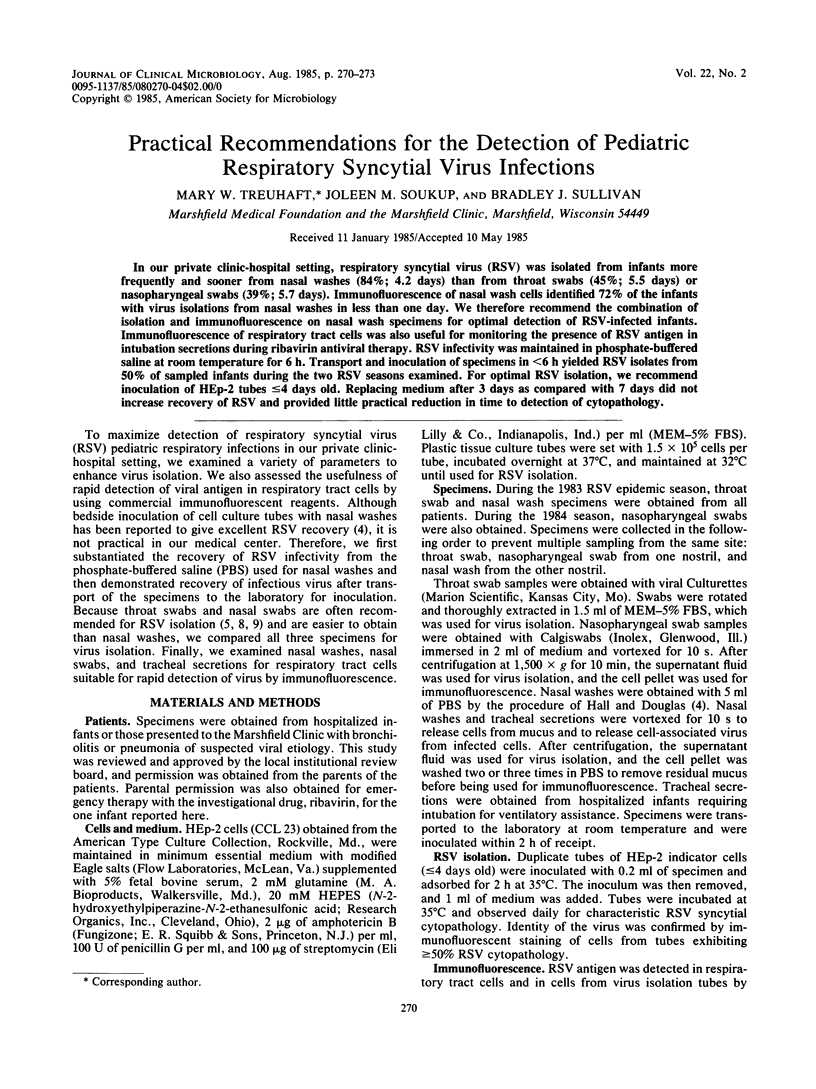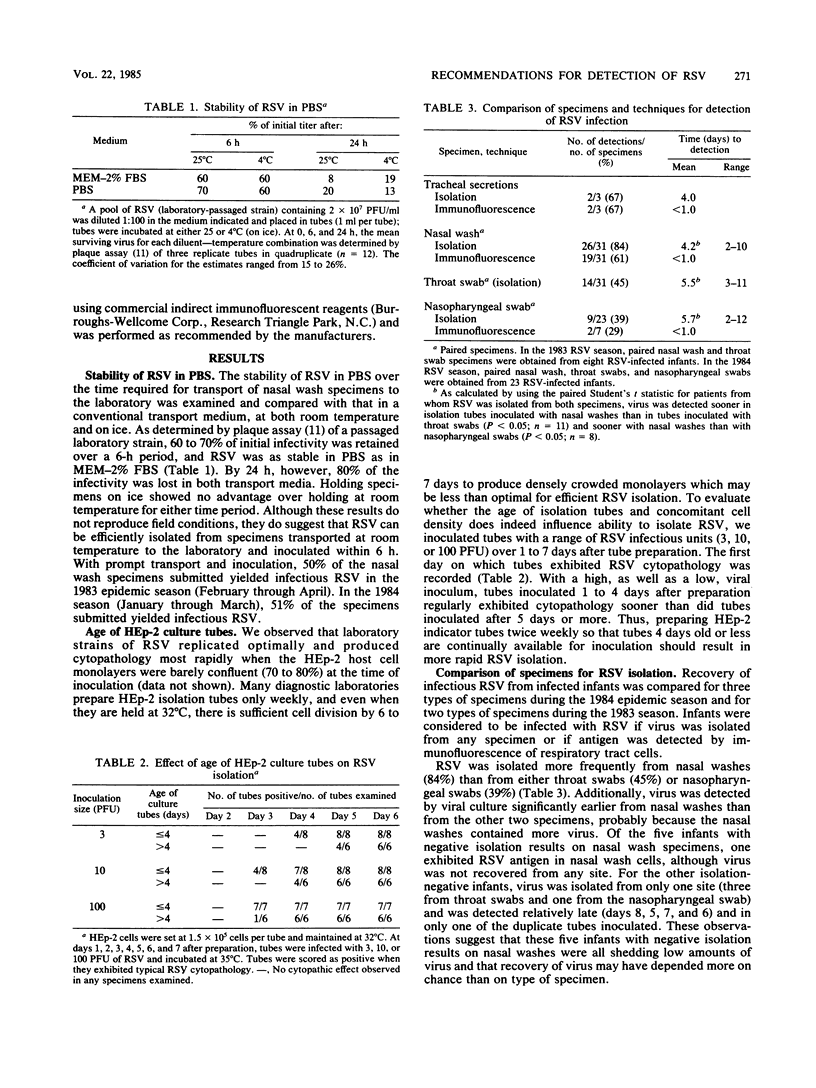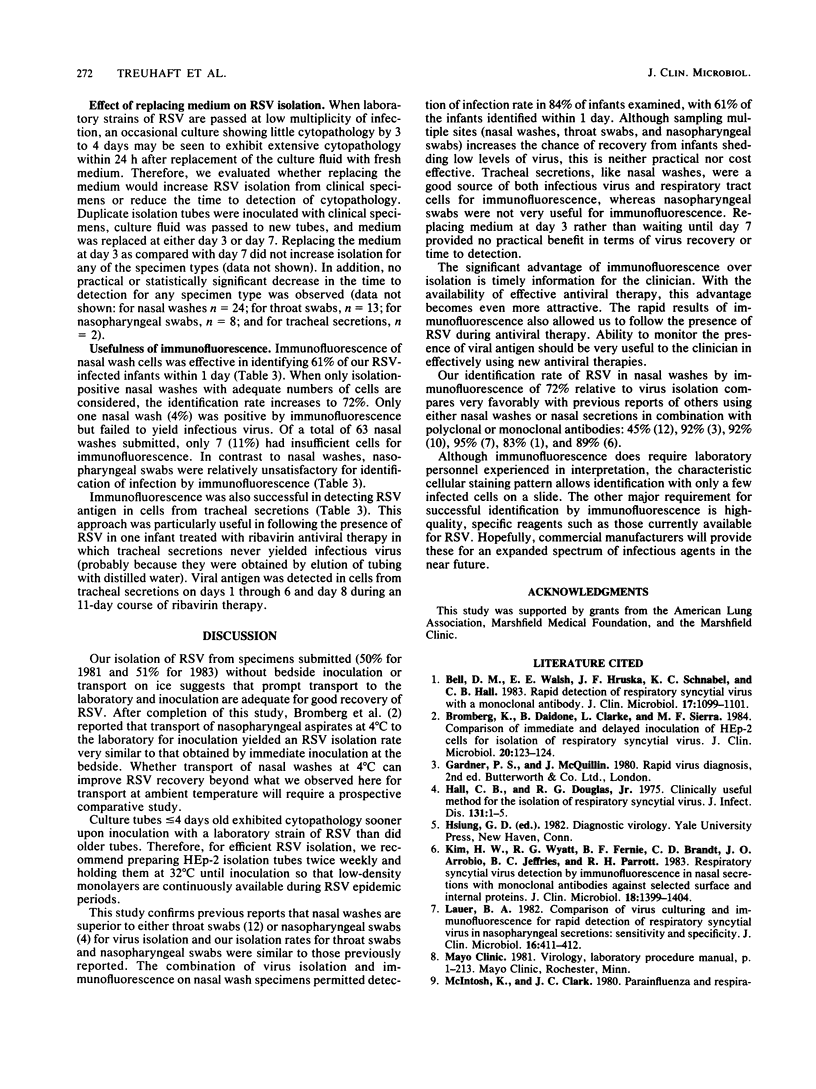Abstract
In our private clinic-hospital setting, respiratory syncytial virus (RSV) was isolated from infants more frequently and sooner from nasal washes (84%; 4.2 days) than from throat swabs (45%; 5.5 days) or nasopharyngeal swabs (39%; 5.7 days). Immunofluorescence of nasal wash cells identified 72% of the infants with virus isolations from nasal washes in less than one day. We therefore recommend the combination of isolation and immunofluorescence on nasal wash specimens for optimal detection of RSV-infected infants. Immunofluorescence of respiratory tract cells was also useful for monitoring the presence of RSV antigen in intubation secretions during ribavirin antiviral therapy. RSV infectivity was maintained in phosphate-buffered saline at room temperature for 6 h. Transport and inoculation of specimens in less than 6 h yielded RSV isolates from 50% of sampled infants during the two RSV seasons examined. For optimal RSV isolation, we recommend inoculation of HEp-2 tubes less than or equal to 4 days old. Replacing medium after 3 days as compared with 7 days did not increase recovery of RSV and provided little practical reduction in time to detection of cytopathology.
Full text
PDF



Selected References
These references are in PubMed. This may not be the complete list of references from this article.
- Bell D. M., Walsh E. E., Hruska J. F., Schnabel K. C., Hall C. B. Rapid detection of respiratory syncytial virus with a monoclonal antibody. J Clin Microbiol. 1983 Jun;17(6):1099–1101. doi: 10.1128/jcm.17.6.1099-1101.1983. [DOI] [PMC free article] [PubMed] [Google Scholar]
- Bromberg K., Daidone B., Clarke L., Sierra M. F. Comparison of immediate and delayed inoculation of HEp-2 cells for isolation of respiratory syncytial virus. J Clin Microbiol. 1984 Jul;20(1):123–124. doi: 10.1128/jcm.20.1.123-124.1984. [DOI] [PMC free article] [PubMed] [Google Scholar]
- Hall C. B., Douglas R. G., Jr Clinically useful method for the isolation of respiratory syncytial virus. J Infect Dis. 1975 Jan;131(1):1–5. doi: 10.1093/infdis/131.1.1. [DOI] [PubMed] [Google Scholar]
- Kim H. W., Wyatt R. G., Fernie B. F., Brandt C. D., Arrobio J. O., Jeffries B. C., Parrott R. H. Respiratory syncytial virus detection by immunofluorescence in nasal secretions with monoclonal antibodies against selected surface and internal proteins. J Clin Microbiol. 1983 Dec;18(6):1399–1404. doi: 10.1128/jcm.18.6.1399-1404.1983. [DOI] [PMC free article] [PubMed] [Google Scholar]
- Lauer B. A. Comparison of virus culturing and immunofluorescence for rapid detection of respiratory syncytial virus in nasopharyngeal secretions: sensitivity and specificity. J Clin Microbiol. 1982 Aug;16(2):411–412. doi: 10.1128/jcm.16.2.411-412.1982. [DOI] [PMC free article] [PubMed] [Google Scholar]
- Minnich L., Ray C. G. Comparison of direct immunofluorescent staining of clinical specimens for respiratory virus antigens with conventional isolation techniques. J Clin Microbiol. 1980 Sep;12(3):391–394. doi: 10.1128/jcm.12.3.391-394.1980. [DOI] [PMC free article] [PubMed] [Google Scholar]
- Treuhaft M. W., Beem M. O. Defective interfering particles of respiratory syncytial virus. Infect Immun. 1982 Aug;37(2):439–444. doi: 10.1128/iai.37.2.439-444.1982. [DOI] [PMC free article] [PubMed] [Google Scholar]
- Urquhart G. E., Walker G. H. Immunofluorescence for routine diagnosis of respiratory syncytial virus infection. J Clin Pathol. 1972 Oct;25(10):843–845. doi: 10.1136/jcp.25.10.843. [DOI] [PMC free article] [PubMed] [Google Scholar]


